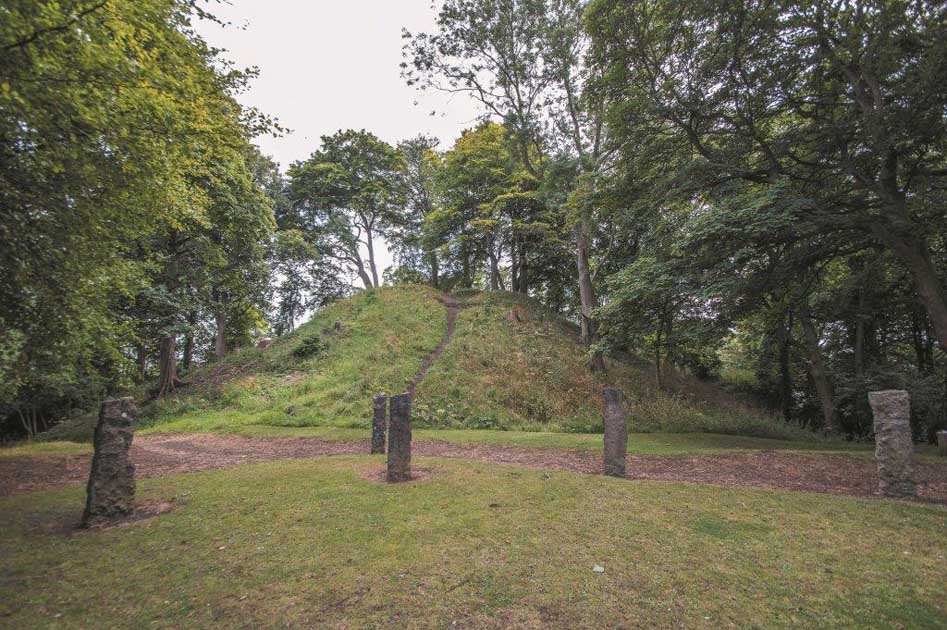Mold Castle

Mold Castle Details
Mold Castle, earthworks of substantial motte & bailey castle, C12-13. Now a public park
- Closest To: Mold
- Access: Free Public Access
- Grid Reference: SJ235643
Mold Castle occupies tee larger of two prominent hills in the centre of the town of Mold, and overlooks the valley of the River Alyn to the north-east. The hill has been scarped and converted to form a substantial motte and bailey fortification, and was almost certainly in use previously as a defensive site. The motte stands some 12 metres above the level of the bailey, and was surrounded by a ditch, although only part of this survives today. The summit of the motte is 23 metres across, which is large enough to house a substantial tower or hall surrounded by a palisade. To the south is a large level bailey area measuring perhaps 60 metres by just over 70 long, this is set maybe 10 metres above the height of surrounding lands, and is curved at the southern end; the south-western corner of the bailey has been quarried away. A sloping ramp ascends the sides of the bailey to a low platform to the north-west of the motte, and a separate area to the south of the bailey may represent an outer bailey or barbican area; today this houses a chapel. There are no surviving remnants of masonry but it seems very likely that the castle at Mold was a stone castle, perhaps with a shell keep at the top of the motte.
Mold Castle is first mentioned in chronicles in 1146, when it was captured and burned to the ground by Owain Gwynedd after many prior attempts to do so by the Welsh, but given the location of Mold in the north-east of Wales, it was almost certainly founded by Robert de Montalt, a knight who owed service to the Earl of Chester, during the invasions into Wales of the 1070s. It was attacked again in 1166, recaptured (or at least repaired) at the cost of King Henry II by 1167 when he erected a hall at the castle, and held by Owain until his death in 1170, when his son Dafydd receiving the lands of Gwynedd east of the Conwy. However, Dafydd resigned Mold to King Henry II in 1177 when he paid the king homage, and Ralph de Montalt was able to return at that date.
In 1199 Llywelyn ab Iorwerth of Gwynedd took the castle from Ralph de Montalt by storm, and was able to hold it in defiance of King John apart from the years of 1210-11, when Ralph’s brother and heir Robert died, and King John asserted his authority. However, after this brief break, Llywelyn again held the castle, right up to his death in 1240. The following year King Henry III took the decision to eject Llywelyn’s son Dafydd from north-east Wales, and it was King Henry who ordered that £40 was to be spent to “repair all that requires repair in the king’s castle.” This is the first time that we know the castle was fortified in stone. It was taken and razed by Dafydd in 1245, but he died the following year, and it was taken by the English again, by treaty on this occasion. It was presumably handed back to the Montalts, who had in the meantime established themselves at Hawarden as their primary seat. It was Roger de Montalt who suffered attacks on his lands by Llywelyn ap Gruffudd and his brother Dafydd in 1256, but the castle held out. It was only in 1260, when King Henry had started to be distracted by his own domestic issues, that Mold fell to the Welsh – and in 1265 Roger lost Hawarden as well. In 1269 Llywelyn seems to have been resident in Mold briefly, but it remained in the hands of the Welsh until the first Welsh War in 1277, when it was taken by the English and garrisoned under Cynwrig Sais for King Edward, who was holding it in ward for the underage Roger de Montalt. Before 1286, Roger married Juliana de Clifford, and as part of the arrangement, her father Roger Clifford received Mold, but he died later the same year, predeceased by his son, and in debt to the Crown, meaning that Mold Castle became crown property. It appears not to have been taken during the second Welsh war, although Hawarden certainly played an important part, but was taken by the Welsh in 1294 during the rebellion of Madog ap Llywelyn. Mold was resigned to Queen Isabella in 1331, and it then remained a royal possession into the late 14th century, when it was granted by Henry IV to John Stanley, later Lord Stanley, and it passed to his son, another John in 1414. References to the “castle and town” of Mold in 1415 and 1421 suggest that up to this time it remained in use – even if only as an administrative centre rather than a military structure. After this it seems likely that the castle fell into disuse, being of secondary importance to the Stanleys. It was much landscaped in the 18th century and is now open to the public as a park.
Become a supporter of my work to access a more detailed history